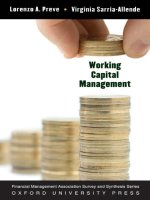- Trang chủ >>
- Khoa Học Tự Nhiên >>
- Vật lý
working capital management apr 2010
Bạn đang xem bản rút gọn của tài liệu. Xem và tải ngay bản đầy đủ của tài liệu tại đây (830.34 KB, 173 trang )
WORKING CAPITAL MANAGEMENT
Financial Management Association
SURVEY AND SYNTHESIS SERIES
Efficient Asset Management: A Practical Guide to Stock Portfolio Optimization
and Asset Allocation
Richard O. Michaud
Real Options: Managing Strategic Investment in an Uncertain World
Martha Amram and Nalin Kulatilaka
Beyond Greed and Fear: Understanding Behavioral Finance and the
Psychology of Investing
Hersh Shefrin
Dividend Policy: Its Impact on Firm Value
Ronald C. Lease, Kose John, Avner Kalay, Uri Loewenstein, and Oded
H. Sarig
Value Based Management: The Corporate Response to Shareholder Revolution
John D. Martin and J. William Petty
Debt Management: A Practitioner’s Guide
John D. Finnerty and Douglas R. Emery
Real Estate Investment Trusts: Structure, Performance, and Investment
Opportunities
Su Han Chan, John Erickson, and Ko Wang
Trading and Exchanges: Market Microstructure for Practitioners
Larry Harris
Valuing the Closely Held Firm
Michael S. Long and Thomas A. Bryant
Last Rights: Liquidating a Company
Dr. Ben S. Branch, Hugh M. Ray, and Robin Russell
Efficient Asset Management: A Practical Guide to Stock Portfolio Optimization
and Asset Allocation, Second Edition
Richard O. Michaud and Robert O. Michaud
Real Options in Theory and Practice
Graeme Guthrie
Slapped by the Invisible Hand: The Panic of 2007
Gary B. Gorton
Working Capital Management
Lorenzo A. Preve and Virginia Sarria-Allende
WORKING CAPITAL MANAGEMENT
Lorenzo A. Preve
Virginia Sarria-Allende
1
2010
1
Oxford University Press, Inc., publishes works that further
Oxford University’s objective of excellence
in research, scholarship, and education.
Oxford New York
Auckland Cape Town Dar es Salaam Hong Kong Karachi
Kuala Lumpur Madrid Melbourne Mexico City Nairobi
New Delhi Shanghai Taipei Toronto
With offices in
Argentina Austria Brazil Chile Czech Republic France Greece
Guatemala Hungary Italy Japan Poland Portugal Singapore
South Korea Switzerland Thailand Turkey Ukraine Vietnam
Copyright © 2010 by Oxford University Press, Inc.
Published by Oxford University Press, Inc.
198 Madison Avenue, New York, New York 10016
www.oup.com
Oxford is a registered trademark of Oxford University Press
All rights reserved. No part of this publication may be reproduced,
stored in a retrieval system, or transmitted, in any form or by any means,
electronic, mechanical, photocopying, recording, or otherwise,
without the prior permission of Oxford University Press.
Library of Congress Cataloging-in-Publication Data
Preve, Lorenzo A.
Working capital management / Lorenzo Preve
and Virginia Sarria-Allende.
p. cm. — (Financial management association survey and synthesis series)
Includes bibliographical references and index.
ISBN 978-0-19-973741-3
1. Working capital. I. Sarria-Allende, Virginia. II. Title.
HG4028.W65P74 2010
658.15'244dc22
2009030286
987654321
Printed in the United States of America
on acid-free paper
Preface
The importance of working capital management became clear to us several years ago. There were two main reasons for this fact. First, we live, do
research, teach, and work with firms in an emerging market, in which a
sound working capital management can explain the difference between a
financially distressed and a profitable firm. Second, we have been fortunate to have a great team of colleagues in the finance department at IAE
Business School who have been thinking about and discussing these
issues with us for a while. Javier García Sanchez, José Luis Gomez Lopez
Egea, Guillermo Fraile, Gabriel Noussan, Florencia Paolini and Martín
Pérez de Solay have contributed a great deal in shaping the ideas that
eventually made their way to the pages of this book.
Several professors throughout our formal finance education shaped
the way we think about corporate finance, and part of their contribution
can probably be traced in the pages that follow.
A considerable number of MBA students and executives have been
exposed, along the past several years, to the discussion in this book. The
interaction with them, their interest and passion, and their real-life examples and cases surely helped us to refine and redefine the ideas that we
present in this book. We are indebted to them all.
Finally, we would like to thank our families for supporting us
unconditionally.
This page intentionally left blank
Contents
Introduction ix
1 Corporate Finance
2 Working Capital
3
14
3 Working Capital, Seasonality, and Growth
4 Financial Analysis and Working Capital
5 Cash Management
7 Managing Inventories
71
86
8 Managing Account Payables
97
104
10 Working Capital and Corporate Strategy
11 Working Capital Financing Costs
12 Patterns in Working Capital 134
Notes
143
References
Index
157
153
42
60
6 Managing Account Receivables
9 Short-term Debt
26
127
115
This page intentionally left blank
Introduction
In this book, we discuss the decision of operating investment and the
corresponding financing, one of the most strategic issues in modern corporate finance. This discussion, mostly ignored by academics until recent
years, becomes extremely important when firms expand beyond the
boundaries of efficient financial markets. Most models in corporate
finance understand a firm as a set of assets financed by either financial
debt or equity. Even though this standard framework is useful for analyzing many financial decisions, it might be misleading to guide the crucial
decision of how to define and finance the operating investments of a
firm.
We focus on these aspects of corporate finance by addressing several
important factors. In Chapter 1, we start by presenting the fundamental
framework of corporate finance and the basic financial statements generated by a firm. This chapter helps to set the stage, introducing some key
concepts that will be widely used throughout the rest of the book. In the
second and third chapters, we specifically address the essential understanding of working capital management. We start, in Chapter 2, by
explaining the traditional definition of working capital and continue by
challenging the standard interpretation and use of the concept. Next, we
provide a more comprehensive framework to think about working capital
management. More specifically, we identify the two basic components:
ix
x
working capital management
the investment and the financing components. The investment component, called financial needs for operation (FNOs), represents the operating investment of the firm. The financing component corresponds to the
concept of working capital. In Chapter 3, we study how the size of the
operating investment changes according to the activity level of the firm.
Subsequently, we analyze how the firm should finance this investment
depending on whether it results from growth or permanent change in
trade conditions, or from seasonal variations. It is important to notice
that we constantly shift between investment and financing considerations; one of the main contributions of this book is precisely the emphasis on the relevance of this link when analyzing business strategy. In
Chapter 4, we combine the concepts discussed in the first three chapters
to perform a complete financial analysis. We reorganize all the available
information following the traditional ratio analysis and then suggest its
use in an integrated analytical framework.
The next four chapters are dedicated to the study of the main components of the operating investment of the firm: cash, receivables, inventories, and payables. In Chapter 5, we discuss the reasons why firms hold
cash, analyzing some of the traditional cash models in corporate finance.
Chapter 6 addresses the main implications of investing in clients’ financing. It discusses the financing provided to clients, the reasons why firms
decide to provide such financing, and the importance of credit risk management. In Chapter 7, we discuss the importance of inventory management. Inventories are an important operating decision of the firm, with
deep implications in profitability and financing. Finally, we review the
main theories of inventory management. Last, in Chapter 8, we move to
the other side of the balance sheet and analyze the financing provided by
suppliers. Even if trade credit can be an expensive financing tool, firms
still decide to use it extensively. Together, chapters 6 and 8 provide a
review and general discussion of the main theories of trade credit.
Chapter 9 discusses the role of short-term debt in financing the operating investment. Short-term debt is considered to play a buffer role in
financing the temporary operating investments of the firm. Additionally,
the chapter provides a discussion of the main sources of short-term financial debt.
In chapters 10–12, we emphasize the strategic perspective of
working capital. In Chapter 10, we discuss the role of working capital
management as a strategic tool. We provide an integrated view of
working capital policies, and we discuss how they can be used to help
improve firms’ competitive position. Chapter 11 deals with strategic
issues from the financing perspective. It discusses the cost of capital of
the long-term financing of operating assets. Long-term financing, com-
introduction
xi
posed of long-term debt and equity, has a cost that needs to be considered by top management in order to make sound financial decisions.
Finally, Chapter 12 discusses some of the observed patterns in working
capital around the world.
This is an important book for general managers who need to understand the corporate financial framework. Many books and articles discuss
the big corporate financing decisions; the financial impact of day-to-day
business decisions, however, has been frequently ignored. This book aims
at closing that gap. Therefore, this is a book for functional managers who
need to understand the financial consequences of their operating decisions; this book will show managers (not only financial managers) how
each managerial decision shapes the finance position, the cash flow, and,
consequently, the profitability of the firm. This text is written, to a large
extent, in a casual and nonformal language so as to make it available to a
wide array of readers. No basic prior knowledge of financial, mathematical, or statistical concepts is needed to understand the message we intend
to convey.
This page intentionally left blank
WORKING CAPITAL MANAGEMENT
This page intentionally left blank
1
Corporate Finance
THE BASIC CORPORATE FINANCE FRAMEWORK
Most businesses are started by an investor who is willing to invest his or
her capital in exchange for a return on the investment. How much of a
return? As financial economists would say, the riskier the investment is,
the higher the expected return.
The money that the investor uses to start the firm is referred to as the
firm’s initial capital. This money is invested in what is called the firm’s
assets, which include everything from the most obvious items such as
property, plant, and equipment, inventory, and cash, to less obvious
items such as customers’ financing. In some cases, especially in the case of
small firms, the investor makes all of the firm’s investment decisions. In
other cases, particularly as firms grow, other people—the firm’s management—are tasked with making these decisions.
Aiming to meet investors’ expected returns, after selecting an optimal investment the business must use the investment to produce goods
and/or services that will be sold to customers. In generating these sales,
a firm will incur several costs, for example, materials and production
costs, storage and distribution costs, employee-related costs, and taxes.
What is left after collecting revenues and paying the related costs is the
firm’s profit, which is the basis for estimating the investors’ return on
investment.
3
4
working capital management
Thus far we have focused attention on “an investor” who decides to
apply his or her money to a given business. In reality, however, most businesses do not count on a single investor to finance the entirety of their
assets; rather, they typically have many investors. These investors are not
all alike. For our purposes here, investors can be characterized according
to the type of contract they establish with the firm.
Broadly speaking, we can categorize these contracts into two basic
types: debt contracts and equity contracts.1 A debt contract is one in which
the firm schedules a promised repayment to the investor. The owners of
the corresponding claim are called debt holders. An equity contract, in
contrast, is a contract in which the firm assigns to investors what can be
considered the firm’s residual profit, that is, the profit that is left over after
the firm covers its operating costs and its obligations to debt holders. The
owners of the latter type of claim are named equity holders. Figure 1.1
illustrates this framework.
To summarize, a firm’s main business activities consist of identifying
optimal investments, arranging appropriate financing to sustain the
investment, and using the selected investments to generate revenues from
which operating expenses, debt obligations, and equity holders’ returns
are paid. These activities are summarized in a firm’s financial statements,
which are the set of documents that collect and organize this information. We discuss the two most basic financial statements next.
FINANCIAL STATEMENTS
A firm’s main business activities as described previously are recorded in
two basic financial statements: (1) the balance sheet and (2) the income
Debt
Investors
Investments
Managers
Capital
Equity
Investors
Returns
Cost of
Capital
Figure 1.1. The Basic Corporate Finance Framework
Expected
Returns
corporate finance
5
statement. In the following paragraphs, we describe both the primary
characteristics of each financial report taken separately and the interaction between the two statements. This interaction is important as it
allows analysts to get a more complete picture of a company’s financial
situation and business performance.
The Balance Sheet
The balance sheet provides a snapshot of the firm at a given moment in
time. This report has two main parts: the left-hand side, which presents
the assets of the firm, and the right-hand side, which shows the corresponding liabilities. The assets represent the investments made by the
firm, whereas the liabilities characterize the way those assets have been
financed. It is easy to see that both parts of the balance sheet reflect two
sides of the same coin: one cannot be affected without altering the other,
and both have the same size (i.e., the assets are equal to the liabilities). For
example, if we make a new investment, it is either because we have
obtained new financing that allows for it (increasing both assets, reflecting the investment, and liabilities, reflecting the financing), or because
we have funded it with the proceeds of a divestiture of a previous investment (leaving the total amount of assets and liabilities unchanged).
Similarly, if we obtain new financing, we can accumulate cash or buy
goods or equipment (increasing both assets and liabilities), or we can use
the money to cancel some previous claim (leaving the total figures
unchanged).
The items reported on a balance sheet are presented in an order that
follows convention. In particular, assets are organized by liquidity (i.e.,
the ease with which a given asset can be converted into cash), and liabilities are organized based on exigibility (i.e., when each liability is due).2
On the asset side, items are sorted by descending liquidity, with the most
liquid assets at the top of the list and the least liquid ones at the bottom.3
According to this rule, a firm’s assets could plausibly be ordered as follows: cash, bank accounts, marketable securities, trade receivables, inventories, and, at the very bottom, property, plant, and equipment (PPE).
Note that these assets are grouped into two broad categories: short-term
or current assets, which are expected to become liquid within one year,
and fixed or noncurrent assets, which are expected to take more than a year
to become liquid. Short-term assets often include items such as cash,
banking accounts, trade receivables, and inventories, and typical noncurrent assets include PPE and goodwill.
On the liabilities side of the balance sheet, the accounts are classified
based on exigibility, with the most exigible claim (the claim due soonest)
presented at the top and the least exigible claim (the furthest-dated claim)
6
working capital management
listed at the bottom. The least exigible claim consists of equity, since equity
holders receive their part after all other obligations have been satisfied.
Long-term debt is listed above equity, and before long-term debt are the
different sources of short-term financing. Typically, the first type of obligation listed is commercial credit, which consists of obligations the firm has
with suppliers who sell their goods or services to the firm on credit, as such
obligations are usually due within a number of days. Wages and other
obligations due to employees in exchange for labor and managerial services are often listed next, as such payments are usually made on a monthly
basis, with employees effectively extending short-term credit to the firm.
Also included among the short-term liabilities are taxes owed to the government, which are accrued based on profit generation but only exigible
on a monthly or quarterly basis, and payments owed on financial debt
such as short-term bank loans or commercial paper.
Figure 1.2 provides an example of a representative firm’s balance
sheet.
As we mentioned earlier, the balance sheet provides a snapshot of a
firm’s investments and corresponding financing at a given point in time.
One can take such snapshots on a monthly, quarterly, yearly, or other
periodic basis and then compare these snapshots to analyze the evolution
of the firm’s investments and financing over time. When analyzing a
firm’s investments, we care about not only the size of total investments
but also their main drivers—the inferences we draw about what is happening to a firm that is showing an increase in its trade receivables might
be dramatically different from those we reach about a firm that is
Current Assets
Cash & Bank Accounts
Trade Receivables
Inventories
Other Current Assets
Current Liabilities
Suppliers
Employees
ST Financial Debt
Taxes
Noncurrent
Liabilities
Noncurrent Assets
Goodwill
PP&E
LT Financial Debt
Other LT Liab.
Other LT Assets
Shareholders’
Equity
Figure 1.2. The Balance Sheet
corporate finance
7
observing an increase in inventories. Similarly, when analyzing the evolution of, say, a growing firm’s financing, it is important to look at whether
the growth has been financed with (short- or long-term) debt or equity,
as the financing choice will significantly impact a company’s performance
and risk exposure.
The previous discussion suggests that analysis of a firm’s balance sheets
can reveal extremely rich and interesting insights on the firm’s performance. However, in order to have a more complete understanding of the
firm’s evolution, we need to have information on what has happened
between consecutive reports. For example, changes in inventory across
balance sheets are linked to how much the firm has bought and sold
between report dates, and changes in equity financing are related to the
amount of net income the firm has been able to generate. Information on
firm activity between balance sheets can be obtained by looking at the
second basic financial statement, the income statement, which is also
called the profit and loss statement, or the P&L statement for short. One
can think of the income statement as the movie that tells the story of the
company between each pair of balance sheet snapshots.
The Income Statement
The income statement is a representation of a firm’s normal business
operations between two consecutive balance sheet statements. In particular, it records the firm’s total sales and costs incurred over the period, from
which the firm’s net income (or profit) is calculated. As is the case for
balance sheets, the income statement can be prepared for any desired
period of time (a week, a month, a quarter, a year, etc.). Typically, a oneyear interval is used for tax and most legal purposes, but many firms also
use quarterly or monthly income statements for different types of supplementary analysis. Later in the chapter we discuss the various components
of a firm’s income statement and then turn to the derivation of net income
(profit).
The first item reported on an income statement is the firm’s total sales,
which is computed by adding all the invoices generated over the period.
It is important to notice that at this stage we do not take into account
whether these invoices have been paid or are still outstanding; we will
consider this distinction in a subsequent chapter.4
Next, the income statement records the costs of the goods sold over the
period. This item includes, among other things, those expenditures directly
related to producing the goods that have been sold over the period, for
instance, the raw materials used to produce these goods. Note that
expenditures incurred over the period that are related to goods that were
not sold but that are stored as inventory (either as raw material or as
8
working capital management
intermediate or final goods) are not counted as costs in the income statement; instead, these expenditures are recorded as assets, since they are
regarded as an investment that will allow the firm to generate future sales.
To illustrate this distinction, consider the case of a firm that produces
dining room sets. Assume that in the period under analysis, say a month,
the firm produces and sells 5 dining room sets, each using 40 pounds of
wood. The firm’s total sales for the month will equal the 5 dining room
sets sold over the month times the price per dining room set sold, and the
firm’s cost of goods sold will equal 40 pounds of wood times the cost of
the wood per pound times the 5 dining room sets that have been sold.
No problem so far, as we are making the important assumption that the
firm bought the exact amount of wood needed to produce the items sold
over the period. What happens, however, if we relax this assumption?
Imagine now that the firm purchased enough wood to produce 10 dining
room sets, but continued to produce and sell only 5 dining room sets. In
this case, the firm would show the same total sales and the same cost of
goods sold as before, but would now also show an increase in wood stored
in inventory. The expenditure associated with this surplus wood is
recorded an asset, as this wood will allow the firm to produce more dining room sets to be sold in the future. Note that it does not matter
whether this surplus wood was acquired intentionally as an investment in
future production capabilities or unintentionally as a result of weaker
sales than expected—the accounting implications for the cost of goods
sold and inventory are identical.
Other costs recorded in the income statement include the costs of
keeping the company operational. Some of these costs vary with the level
of production, whereas others are independent of production levels and
are said to be fixed. Regardless of whether variable or fixed, these operating costs are recognized on the basis of their relation with the sales and
other business activity generated during the period, not on the basis of
whether they have been paid during the period. Other financial reports,
as we will see when we turn to sources and uses of funds, concentrate on
actual cash flows.
We are now ready to discuss the derivation of a firm’s net income. The
first two lines of the income statement present the firm’s total sales and
corresponding cost of goods sold (CGS), which includes raw materials,
labor, and variable operating costs. Subtracting CGS from sales gives the
firm’s gross margin, which is the income obtained before deducting any
fixed costs.5 Subtracting fixed costs from the gross margin gives earnings
before interest and taxes (EBIT), and subtracting interest expenses from
EBIT yields earnings before taxes (EBT). After deducting taxes, we get
the firm’s bottom line, that is, its net income or profit.
corporate finance
Minus
Net Sales
Cost of Goods Sold
Minus
Gross Profit (or Contribution Margin)
Fixed Costs
Minus
EBIT
Interest Expenses
Minus
9
Income Before Taxes
Income Taxes
Net Income
Figure 1.3. The Income Statement
The sample income statement shown in Figure 1.3 illustrates how a
firm’s net income, or profit, is calculated.
As these discussions suggest, there is a strong connection between balance sheets and income statements—a change to one automatically
affects the other. Understanding this interaction is crucial to reach a
sound conclusion about business performance and profitability.
To recap so far, we have shown that the firm invests in assets that are
used to produce goods and services that will be sold to customers, and
that this production process has embedded costs. The P&L statement
shows the accounting profit generated by the firm’s operation. Since
investors are paid from such profit, clearly this measure is of interest to
investors. However, profit is not the only measure of interest, as it is not
always a good proxy for the wealth generated by a given investment. In
particular, investors also care about the cash flows of the firm. More specifically, investors consider the amount of cash that they invested and
compare this value with the amount of cash that the investment returns
to them, or their return on investment. We discuss this measure next.
RETURN ON INVESTMENT
When cash enters the company from sales, management distributes the
cash among the firm’s various claim holders.6 The first group of claim
holders to be paid consists of employees and suppliers. After this group of
claim holders has been satisfied, the remaining cash is distributed among
financial claim holders. First among such claim holders are debt holders,
who are paid in accordance with the seniority of their claim and the terms
of the firm’s debt contracts. Next in line is the federal tax authority, which
has a claim on the firm’s profit. Finally, after paying employees, suppliers,
debt holders, and the tax authority, the balance is distributed to equity
holders, who are also called shareholders. Note that this does not mean
10
working capital management
Suppliers
Employees
Investments
Financial Debt
Shareholders’
Equity
Figure 1.4. The Distribution of the Firm’s Cash Flows
that the shareholders will receive all of the cash that remains after the firm’s
other obligations are met. Rather, the company will have set a dividend
policy that depends, among other things, on the firm’s industry and financial condition. This policy will allocate to equity holders a dividend distribution. The balance is held to be reinvested in the firm.7
Figure 1.4 illustrates the distribution of a firm’s cash receipts, and in
particular how an investor’s return on investment is determined. Note
that the arrows show the direction of the firm’s cash flows according to
the seniority of claims.
From the previous discussion, it is clear how financial investors are
paid from the cash flows that the firm generates. The remaining question
is whether the payment received is high enough to satisfy investors’ ex
ante expected returns. We briefly discuss this issue in the next section.
INVESTORS’ EXPECTED RETURN—THE COST OF CAPITAL
At the beginning of this chapter, we stated that investors are willing to
invest their capital in exchange for a return, where the expected return
increases with the risk of the investment. From the previous discussion
on the allocation of generated cash flows, it is clear that different claim
holders bear different levels of risk. For instance, while employees, suppliers, and debt holders enjoy a promise to be paid according to a schedule
of payments, shareholders have no such promise; instead, given their subordinate claims, they are entitled to some return only after everyone else
has been paid. As a result, shareholders clearly have higher risk exposure
than other, higher priority claim holders.
corporate finance
11
Given that different claim holders have different degrees of risk, how
can we characterize the return requirements of different investors?
Consider an investor bearing no risk. This investor would be expected
to require the risk-free rate of return. Now consider an investor who
invests on a risky asset. Given that this investor can always obtain a
risk-free return (simply by buying a U.S. Treasury bond), he or she
would not be willing to accept a return lower than the risk-free rate.
Moreover, the investor will require a premium over the risk-free rate to
agree to invest in the risky asset, as otherwise could obtain the risk-free
rate at lower risk by investing in the risk-free asset. Note that investment risk varies not only by type of claim on the firm but also across
firms, industries, and countries. Thus, expected returns will vary along
these dimensions, too.
Based on the previous arguments, we can express investors’ expected
return in general form as follows:
Expected Return = Rf + Risk Premium,
where Rf is the return promised by a risk-free investment and risk premium is the extra return that an investor requires for an investment with
a given level of risk. However, since debt holders and equity holders take
different risks, their risk premium will certainly differ. Thus, when thinking about expected returns, the two most common approaches are to
consider either the combined expected return of debt and equity holders
as a group or the expected return of shareholders alone.
To consider the expected return of shareholders alone, let the cost of
equity be denoted by Ke. We can then say that equity holders’ expected
return is given by:
Ke = Rf + Risk Premiume.
For completeness, with the cost of debt denoted by Kd, we have that the
expected return to debt holders is given by:
Kd = Rf + Risk Premiumd .
Notice that since equity holders face more ex ante risk than debt holders,
and Rf is the same for both equations, it follows that Risk Premiume > Risk
Premiumd and hence Ke > Kd , reflecting equity holders’ higher risk and
associated higher expected return.
The expression for the combined expected return of both debt and
equity holders is called the weighted average cost of capital (WACC), as
12
working capital management
Debt
Holders
Kd = Rf + RPd
WACC
Investments
Equity
Holders
Ke = Rf + RPe
Figure 1.5. The Cost of Capital
the expected return is the firm’s cost due to investors in exchange for
receiving investment capital. WACC is computed as:
WACC = K e ×
E
D
,
+ K d × (1 − t ) ×
D +E
D+E
where Ke and Kd are as defined previously, E / (D + E) and D / (D + E) are the
weights that equity and debt contribute to finance the investment, and t is
the marginal income tax rate. Taxes enter the equation so as to allow us to
compute the after-tax cost of capital. That is, since interest expenses can be
deducted before determining taxable income, each dollar paid to the bank
saves t dollars of taxes. As a result, the after-tax cost of debt is Kd ´ (1 – t).
Figure 1.5 summarizes how we compute investors’ combined expected
return, or the cost of capital.
Managers tend to look carefully at the expected returns of their investors in an attempt to improve their ability to meet or beat (in the case of
equity, only) these expectations. In the context of this book, which focuses
on working capital management, we do not go further into the specific
calculations necessary to determine each type of investor’s risk premium,
one of the most important and debated topics in corporate finance.
Rather, we simply take risk premiums as a given, with the understanding
that investors are willing to invest in exchange for a compensation that at
least meets the minimum return required for the level of risk that investors face.
CONCLUSION
In this introductory chapter, we presented a very simple framework of
financial accounting, we introduced the two most basic financial statements,









